Renaissance Humanism Kenesbekov Erlan Palmahanbetov Azamat Humanism
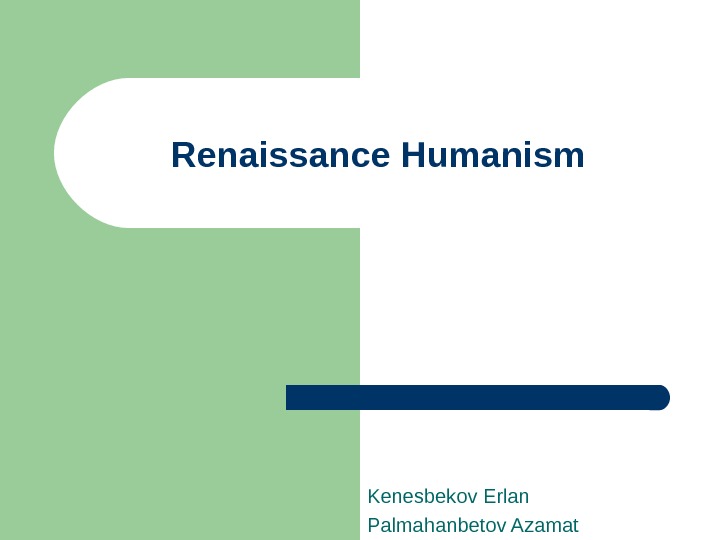
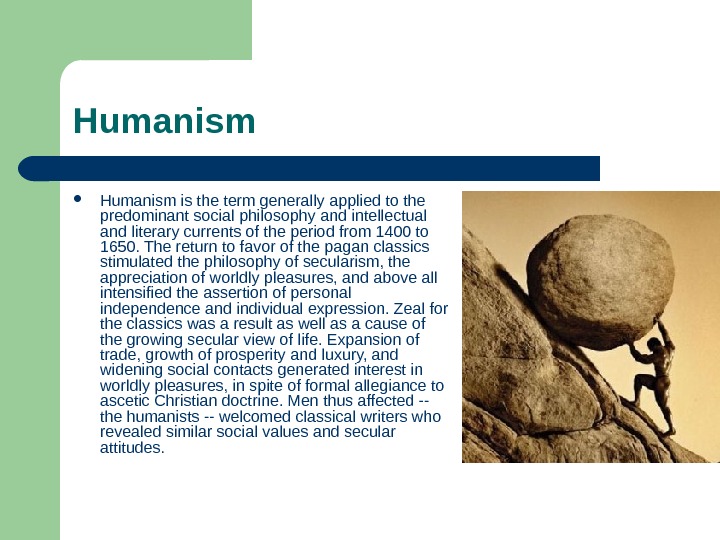
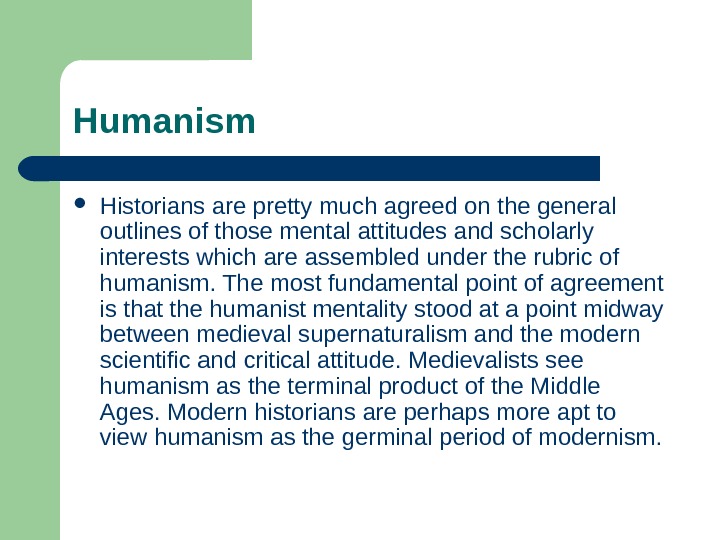
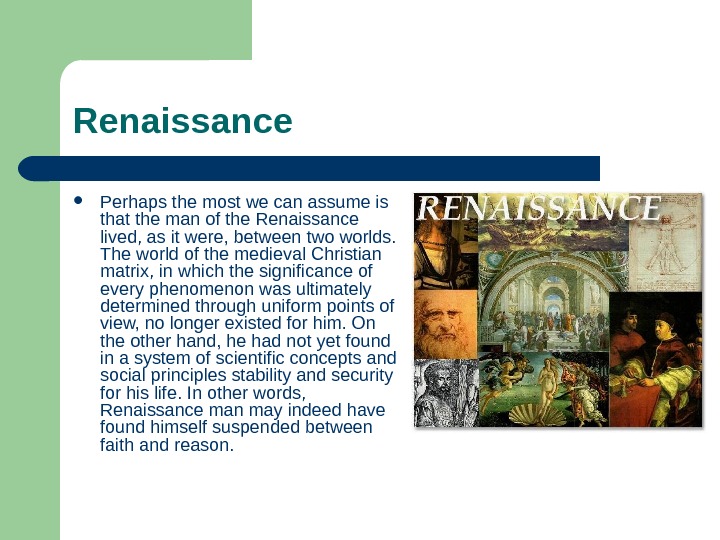
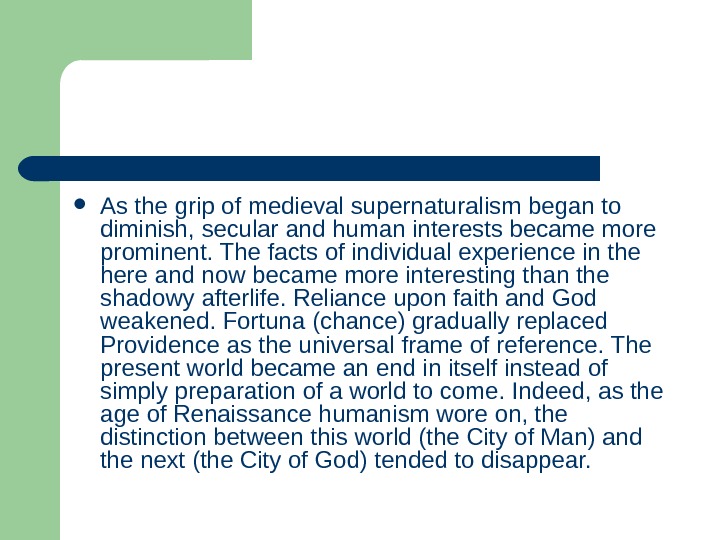

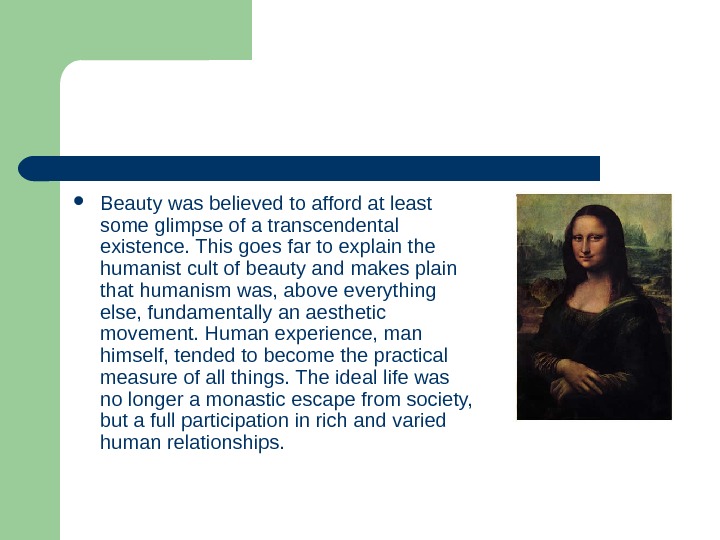
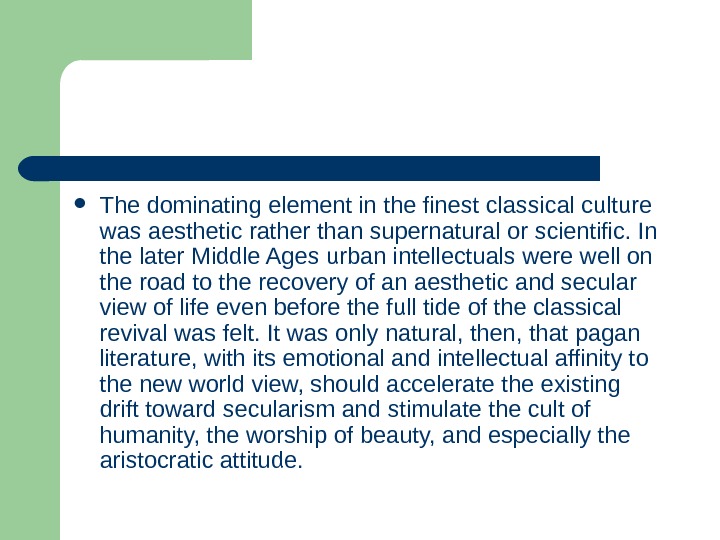
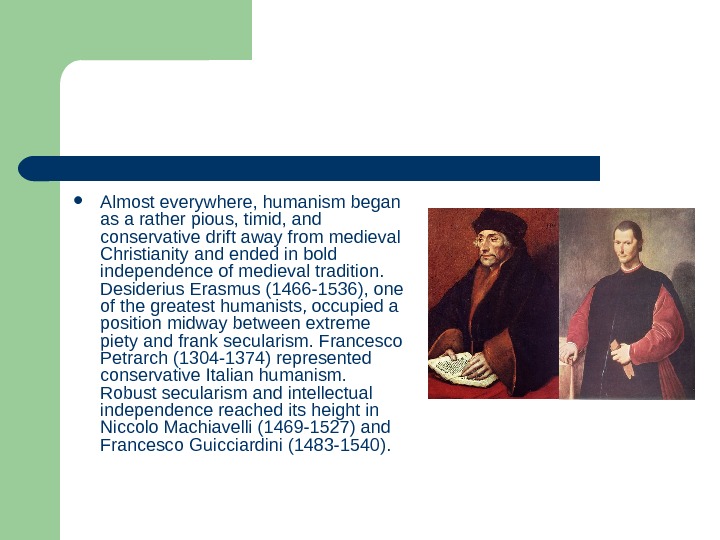


renaissance_humanism.ppt
- Размер: 351 Кб
- Количество слайдов: 11
Описание презентации Renaissance Humanism Kenesbekov Erlan Palmahanbetov Azamat Humanism по слайдам
 Renaissance Humanism Kenesbekov Erlan Palmahanbetov Azamat
Renaissance Humanism Kenesbekov Erlan Palmahanbetov Azamat
 Humanism is the term generally applied to the predominant social philosophy and intellectual and literary currents of the period from 1400 to 1650. The return to favor of the pagan classics stimulated the philosophy of secularism, the appreciation of worldly pleasures, and above all intensified the assertion of personal independence and individual expression. Zeal for the classics was a result as well as a cause of the growing secular view of life. Expansion of trade, growth of prosperity and luxury, and widening social contacts generated interest in worldly pleasures, in spite of formal allegiance to ascetic Christian doctrine. Men thus affected — the humanists — welcomed classical writers who revealed similar social values and secular attitudes.
Humanism is the term generally applied to the predominant social philosophy and intellectual and literary currents of the period from 1400 to 1650. The return to favor of the pagan classics stimulated the philosophy of secularism, the appreciation of worldly pleasures, and above all intensified the assertion of personal independence and individual expression. Zeal for the classics was a result as well as a cause of the growing secular view of life. Expansion of trade, growth of prosperity and luxury, and widening social contacts generated interest in worldly pleasures, in spite of formal allegiance to ascetic Christian doctrine. Men thus affected — the humanists — welcomed classical writers who revealed similar social values and secular attitudes.
 Humanism Historians are pretty much agreed on the general outlines of those mental attitudes and scholarly interests which are assembled under the rubric of humanism. The most fundamental point of agreement is that the humanist mentality stood at a point midway between medieval supernaturalism and the modern scientific and critical attitude. Medievalists see humanism as the terminal product of the Middle Ages. Modern historians are perhaps more apt to view humanism as the germinal period of modernism.
Humanism Historians are pretty much agreed on the general outlines of those mental attitudes and scholarly interests which are assembled under the rubric of humanism. The most fundamental point of agreement is that the humanist mentality stood at a point midway between medieval supernaturalism and the modern scientific and critical attitude. Medievalists see humanism as the terminal product of the Middle Ages. Modern historians are perhaps more apt to view humanism as the germinal period of modernism.
 Renaissance Perhaps the most we can assume is that the man of the Renaissance lived, as it were, between two worlds. The world of the medieval Christian matrix, in which the significance of every phenomenon was ultimately determined through uniform points of view, no longer existed for him. On the other hand, he had not yet found in a system of scientific concepts and social principles stability and security for his life. In other words, Renaissance man may indeed have found himself suspended between faith and reason.
Renaissance Perhaps the most we can assume is that the man of the Renaissance lived, as it were, between two worlds. The world of the medieval Christian matrix, in which the significance of every phenomenon was ultimately determined through uniform points of view, no longer existed for him. On the other hand, he had not yet found in a system of scientific concepts and social principles stability and security for his life. In other words, Renaissance man may indeed have found himself suspended between faith and reason.
 As the grip of medieval supernaturalism began to diminish, secular and human interests became more prominent. The facts of individual experience in the here and now became more interesting than the shadowy afterlife. Reliance upon faith and God weakened. Fortuna (chance) gradually replaced Providence as the universal frame of reference. The present world became an end in itself instead of simply preparation of a world to come. Indeed, as the age of Renaissance humanism wore on, the distinction between this world (the City of Man) and the next (the City of God) tended to disappear.
As the grip of medieval supernaturalism began to diminish, secular and human interests became more prominent. The facts of individual experience in the here and now became more interesting than the shadowy afterlife. Reliance upon faith and God weakened. Fortuna (chance) gradually replaced Providence as the universal frame of reference. The present world became an end in itself instead of simply preparation of a world to come. Indeed, as the age of Renaissance humanism wore on, the distinction between this world (the City of Man) and the next (the City of God) tended to disappear.

 Beauty was believed to afford at least some glimpse of a transcendental existence. This goes far to explain the humanist cult of beauty and makes plain that humanism was, above everything else, fundamentally an aesthetic movement. Human experience, man himself, tended to become the practical measure of all things. The ideal life was no longer a monastic escape from society, but a full participation in rich and varied human relationships.
Beauty was believed to afford at least some glimpse of a transcendental existence. This goes far to explain the humanist cult of beauty and makes plain that humanism was, above everything else, fundamentally an aesthetic movement. Human experience, man himself, tended to become the practical measure of all things. The ideal life was no longer a monastic escape from society, but a full participation in rich and varied human relationships.
 The dominating element in the finest classical culture was aesthetic rather than supernatural or scientific. In the later Middle Ages urban intellectuals were well on the road to the recovery of an aesthetic and secular view of life even before the full tide of the classical revival was felt. It was only natural, then, that pagan literature, with its emotional and intellectual affinity to the new world view, should accelerate the existing drift toward secularism and stimulate the cult of humanity, the worship of beauty, and especially the aristocratic attitude.
The dominating element in the finest classical culture was aesthetic rather than supernatural or scientific. In the later Middle Ages urban intellectuals were well on the road to the recovery of an aesthetic and secular view of life even before the full tide of the classical revival was felt. It was only natural, then, that pagan literature, with its emotional and intellectual affinity to the new world view, should accelerate the existing drift toward secularism and stimulate the cult of humanity, the worship of beauty, and especially the aristocratic attitude.
 Almost everywhere, humanism began as a rather pious, timid, and conservative drift away from medieval Christianity and ended in bold independence of medieval tradition. Desiderius Erasmus (1466 -1536), one of the greatest humanists, occupied a position midway between extreme piety and frank secularism. Francesco Petrarch (1304 -1374) represented conservative Italian humanism. Robust secularism and intellectual independence reached its height in Niccolo Machiavelli (1469 -1527) and Francesco Guicciardini (1483 -1540).
Almost everywhere, humanism began as a rather pious, timid, and conservative drift away from medieval Christianity and ended in bold independence of medieval tradition. Desiderius Erasmus (1466 -1536), one of the greatest humanists, occupied a position midway between extreme piety and frank secularism. Francesco Petrarch (1304 -1374) represented conservative Italian humanism. Robust secularism and intellectual independence reached its height in Niccolo Machiavelli (1469 -1527) and Francesco Guicciardini (1483 -1540).
 Rudolphus Agricola (1443 -1485) may be regarded as the German Petrarch. In England, John Colet (c. 1467 -1519) and Sir Thomas More (1478 -1535) were early or conservative humanists, Francis Bacon (1561 -1626) represented later or agnostic and skeptical humanism. In France, pious classicists like Lefиvre d’Йtaples (1453 -1536) were succeeded by frank, urbane, and devout skeptics like Michel Montaigne (1533 -1592) and bold anti-clerical satirists like Franзois Rabelais (c. 1495 -1533).
Rudolphus Agricola (1443 -1485) may be regarded as the German Petrarch. In England, John Colet (c. 1467 -1519) and Sir Thomas More (1478 -1535) were early or conservative humanists, Francis Bacon (1561 -1626) represented later or agnostic and skeptical humanism. In France, pious classicists like Lefиvre d’Йtaples (1453 -1536) were succeeded by frank, urbane, and devout skeptics like Michel Montaigne (1533 -1592) and bold anti-clerical satirists like Franзois Rabelais (c. 1495 -1533).
 Thank You For Your Attention!
Thank You For Your Attention!
